Managing Organisational and Individual Change in the Workplace Essay
VerifiedAdded on 2020/06/06
|7
|1711
|61
Essay
AI Summary
This essay delves into the critical aspects of managing organisational and individual change within a business context. It begins by highlighting the significance of change management for firm growth and the role of employees in adapting to new workplace dynamics. The essay evaluates various change management theories and concepts, including Lewin's three-stage model and the McKinsey 7-S model, analyzing their application in practice. It also examines behavioral approaches, such as reward and punishment systems, to influence individual acceptance of change. The main body applies these theories to a practical scenario, using the author's experience as a bar manager to illustrate challenges and responses to organisational change, such as staffing issues and increased responsibilities. The essay then critically assesses how individual learning and behavior can be shaped to manage change effectively, considering factors like environmental determinism and motivational attributes. The conclusion emphasizes the importance of responsible change management strategies and their impact on both organisational and individual adaptation.
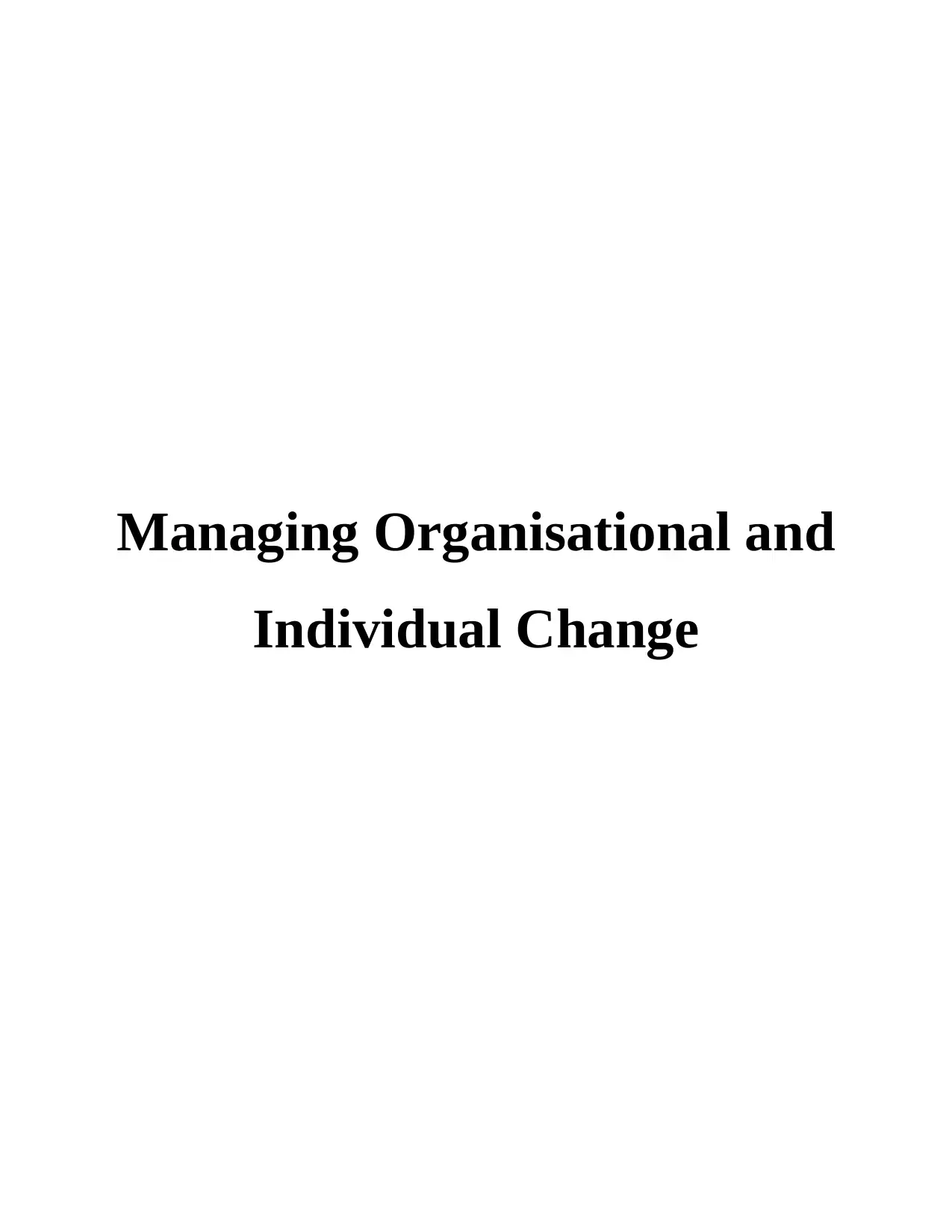
Managing Organisational and
Individual Change
Individual Change
Paraphrase This Document
Need a fresh take? Get an instant paraphrase of this document with our AI Paraphraser
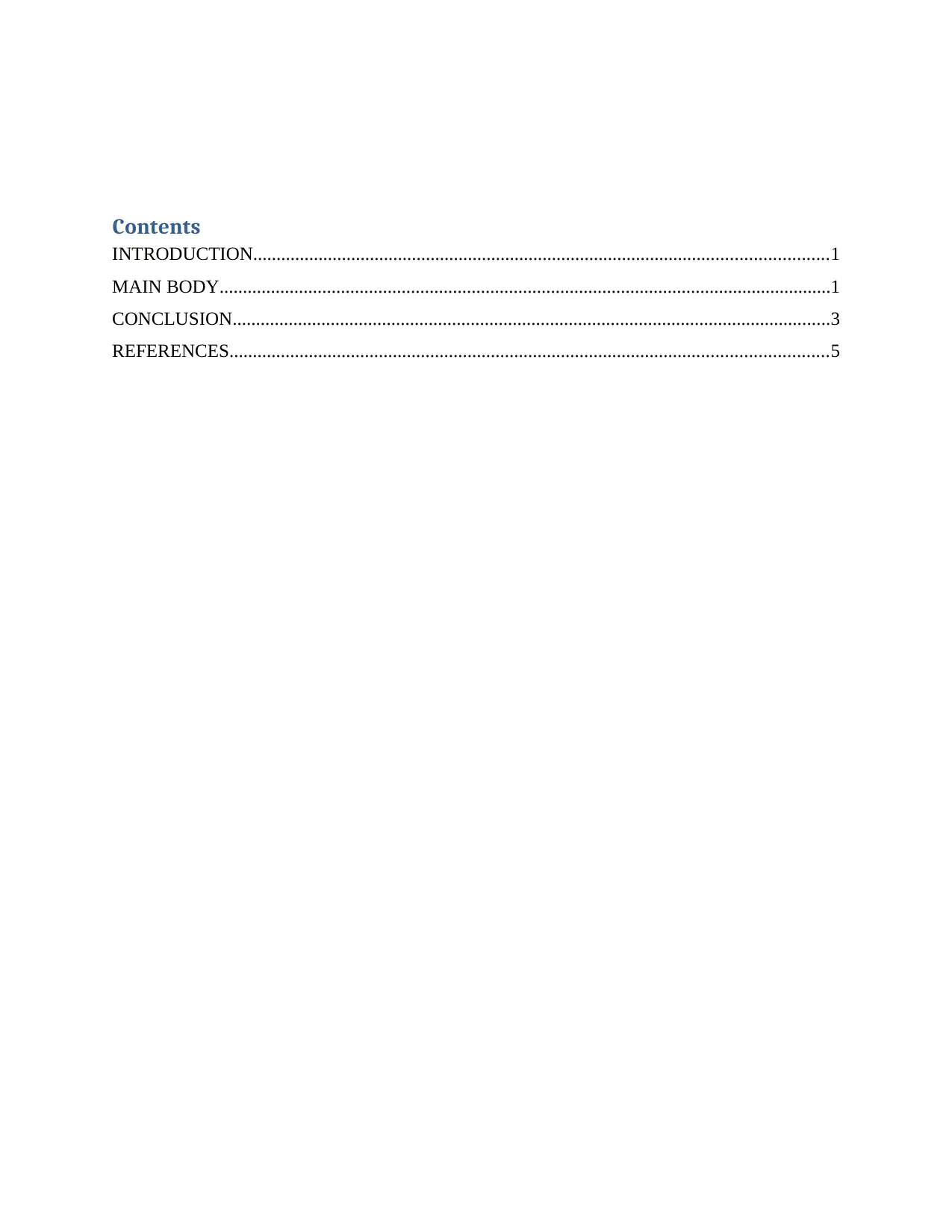
Contents
INTRODUCTION...........................................................................................................................1
MAIN BODY...................................................................................................................................1
CONCLUSION................................................................................................................................3
REFERENCES................................................................................................................................5
INTRODUCTION...........................................................................................................................1
MAIN BODY...................................................................................................................................1
CONCLUSION................................................................................................................................3
REFERENCES................................................................................................................................5
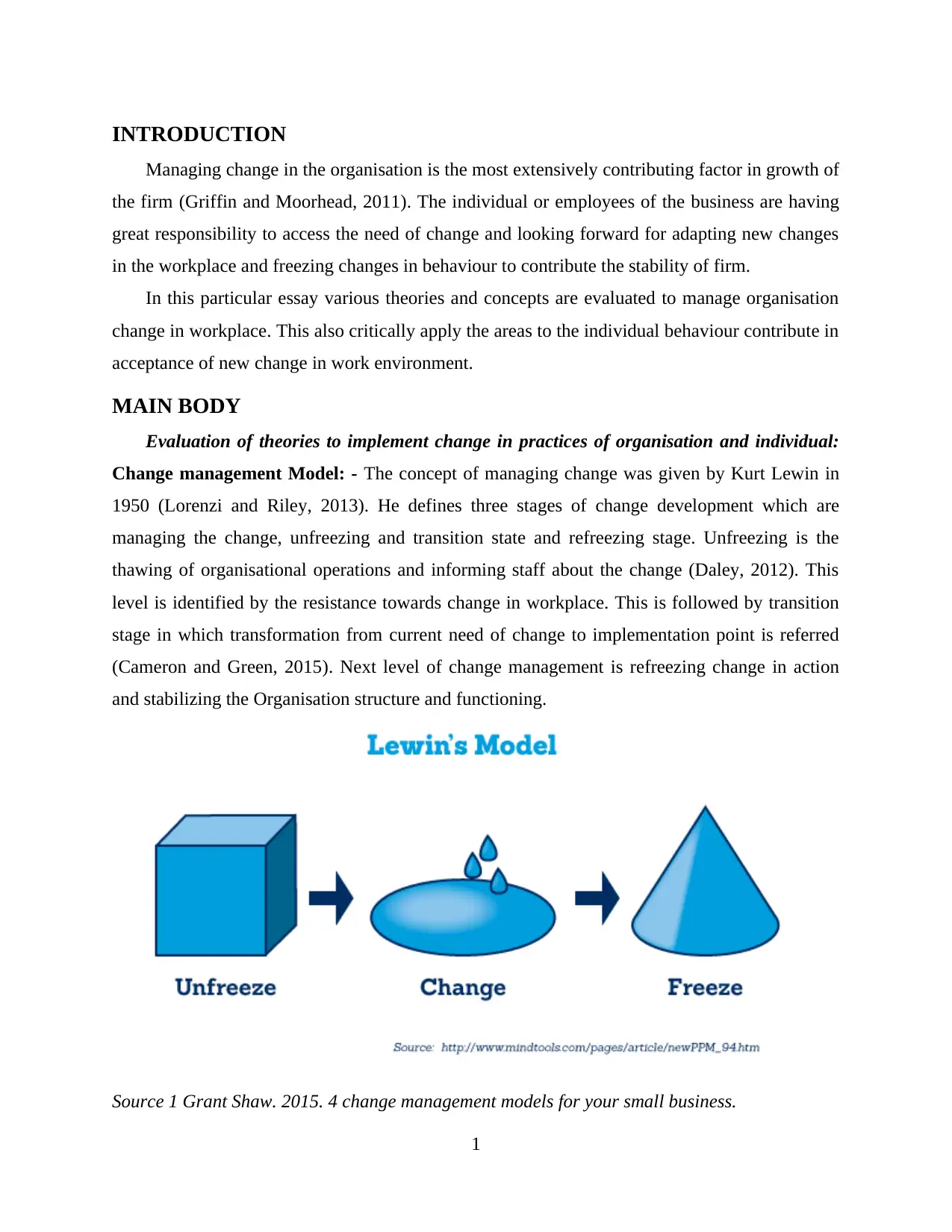
INTRODUCTION
Managing change in the organisation is the most extensively contributing factor in growth of
the firm (Griffin and Moorhead, 2011). The individual or employees of the business are having
great responsibility to access the need of change and looking forward for adapting new changes
in the workplace and freezing changes in behaviour to contribute the stability of firm.
In this particular essay various theories and concepts are evaluated to manage organisation
change in workplace. This also critically apply the areas to the individual behaviour contribute in
acceptance of new change in work environment.
MAIN BODY
Evaluation of theories to implement change in practices of organisation and individual:
Change management Model: - The concept of managing change was given by Kurt Lewin in
1950 (Lorenzi and Riley, 2013). He defines three stages of change development which are
managing the change, unfreezing and transition state and refreezing stage. Unfreezing is the
thawing of organisational operations and informing staff about the change (Daley, 2012). This
level is identified by the resistance towards change in workplace. This is followed by transition
stage in which transformation from current need of change to implementation point is referred
(Cameron and Green, 2015). Next level of change management is refreezing change in action
and stabilizing the Organisation structure and functioning.
Source 1 Grant Shaw. 2015. 4 change management models for your small business.
1
Managing change in the organisation is the most extensively contributing factor in growth of
the firm (Griffin and Moorhead, 2011). The individual or employees of the business are having
great responsibility to access the need of change and looking forward for adapting new changes
in the workplace and freezing changes in behaviour to contribute the stability of firm.
In this particular essay various theories and concepts are evaluated to manage organisation
change in workplace. This also critically apply the areas to the individual behaviour contribute in
acceptance of new change in work environment.
MAIN BODY
Evaluation of theories to implement change in practices of organisation and individual:
Change management Model: - The concept of managing change was given by Kurt Lewin in
1950 (Lorenzi and Riley, 2013). He defines three stages of change development which are
managing the change, unfreezing and transition state and refreezing stage. Unfreezing is the
thawing of organisational operations and informing staff about the change (Daley, 2012). This
level is identified by the resistance towards change in workplace. This is followed by transition
stage in which transformation from current need of change to implementation point is referred
(Cameron and Green, 2015). Next level of change management is refreezing change in action
and stabilizing the Organisation structure and functioning.
Source 1 Grant Shaw. 2015. 4 change management models for your small business.
1
⊘ This is a preview!⊘
Do you want full access?
Subscribe today to unlock all pages.

Trusted by 1+ million students worldwide
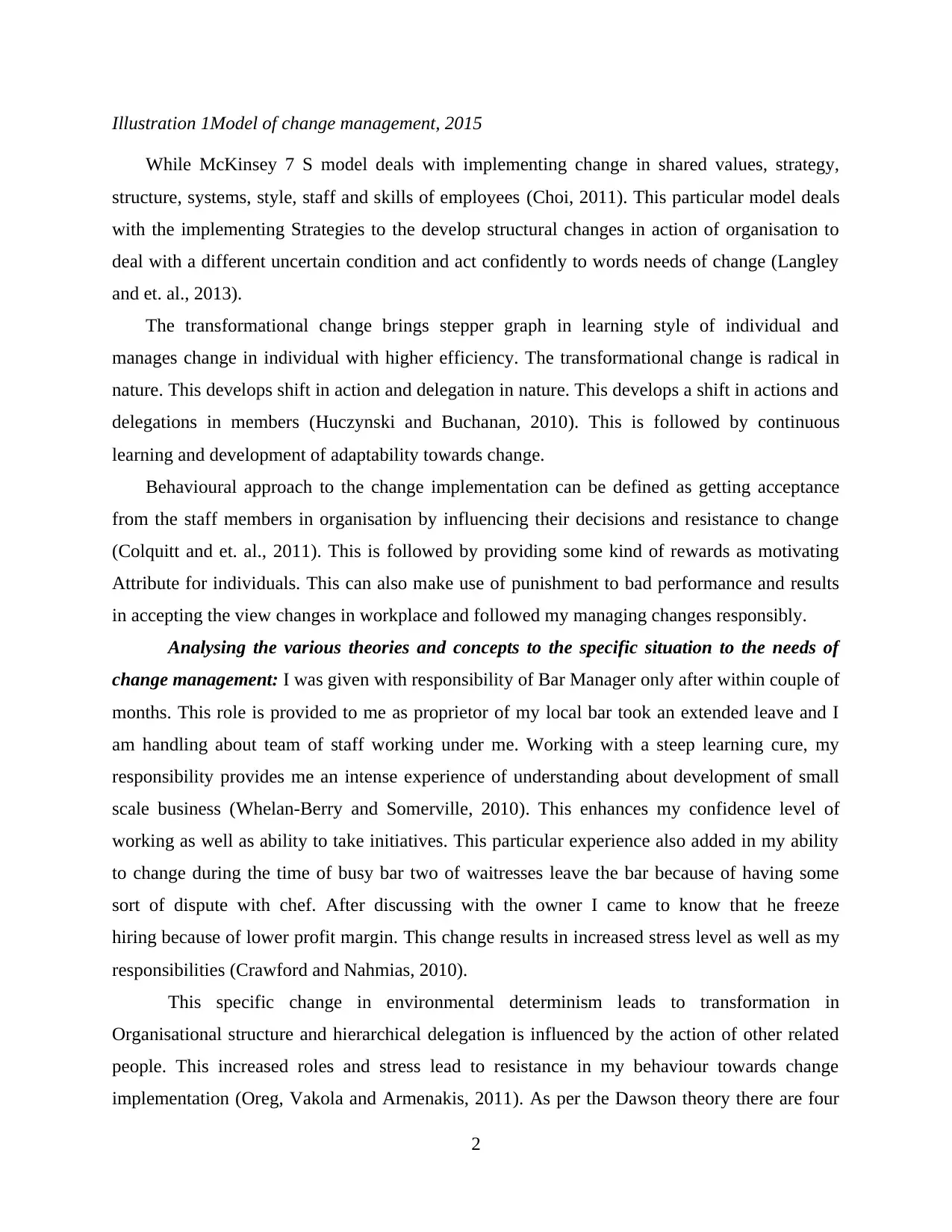
Illustration 1Model of change management, 2015
While McKinsey 7 S model deals with implementing change in shared values, strategy,
structure, systems, style, staff and skills of employees (Choi, 2011). This particular model deals
with the implementing Strategies to the develop structural changes in action of organisation to
deal with a different uncertain condition and act confidently to words needs of change (Langley
and et. al., 2013).
The transformational change brings stepper graph in learning style of individual and
manages change in individual with higher efficiency. The transformational change is radical in
nature. This develops shift in action and delegation in nature. This develops a shift in actions and
delegations in members (Huczynski and Buchanan, 2010). This is followed by continuous
learning and development of adaptability towards change.
Behavioural approach to the change implementation can be defined as getting acceptance
from the staff members in organisation by influencing their decisions and resistance to change
(Colquitt and et. al., 2011). This is followed by providing some kind of rewards as motivating
Attribute for individuals. This can also make use of punishment to bad performance and results
in accepting the view changes in workplace and followed my managing changes responsibly.
Analysing the various theories and concepts to the specific situation to the needs of
change management: I was given with responsibility of Bar Manager only after within couple of
months. This role is provided to me as proprietor of my local bar took an extended leave and I
am handling about team of staff working under me. Working with a steep learning cure, my
responsibility provides me an intense experience of understanding about development of small
scale business (Whelan-Berry and Somerville, 2010). This enhances my confidence level of
working as well as ability to take initiatives. This particular experience also added in my ability
to change during the time of busy bar two of waitresses leave the bar because of having some
sort of dispute with chef. After discussing with the owner I came to know that he freeze
hiring because of lower profit margin. This change results in increased stress level as well as my
responsibilities (Crawford and Nahmias, 2010).
This specific change in environmental determinism leads to transformation in
Organisational structure and hierarchical delegation is influenced by the action of other related
people. This increased roles and stress lead to resistance in my behaviour towards change
implementation (Oreg, Vakola and Armenakis, 2011). As per the Dawson theory there are four
2
While McKinsey 7 S model deals with implementing change in shared values, strategy,
structure, systems, style, staff and skills of employees (Choi, 2011). This particular model deals
with the implementing Strategies to the develop structural changes in action of organisation to
deal with a different uncertain condition and act confidently to words needs of change (Langley
and et. al., 2013).
The transformational change brings stepper graph in learning style of individual and
manages change in individual with higher efficiency. The transformational change is radical in
nature. This develops shift in action and delegation in nature. This develops a shift in actions and
delegations in members (Huczynski and Buchanan, 2010). This is followed by continuous
learning and development of adaptability towards change.
Behavioural approach to the change implementation can be defined as getting acceptance
from the staff members in organisation by influencing their decisions and resistance to change
(Colquitt and et. al., 2011). This is followed by providing some kind of rewards as motivating
Attribute for individuals. This can also make use of punishment to bad performance and results
in accepting the view changes in workplace and followed my managing changes responsibly.
Analysing the various theories and concepts to the specific situation to the needs of
change management: I was given with responsibility of Bar Manager only after within couple of
months. This role is provided to me as proprietor of my local bar took an extended leave and I
am handling about team of staff working under me. Working with a steep learning cure, my
responsibility provides me an intense experience of understanding about development of small
scale business (Whelan-Berry and Somerville, 2010). This enhances my confidence level of
working as well as ability to take initiatives. This particular experience also added in my ability
to change during the time of busy bar two of waitresses leave the bar because of having some
sort of dispute with chef. After discussing with the owner I came to know that he freeze
hiring because of lower profit margin. This change results in increased stress level as well as my
responsibilities (Crawford and Nahmias, 2010).
This specific change in environmental determinism leads to transformation in
Organisational structure and hierarchical delegation is influenced by the action of other related
people. This increased roles and stress lead to resistance in my behaviour towards change
implementation (Oreg, Vakola and Armenakis, 2011). As per the Dawson theory there are four
2
Paraphrase This Document
Need a fresh take? Get an instant paraphrase of this document with our AI Paraphraser
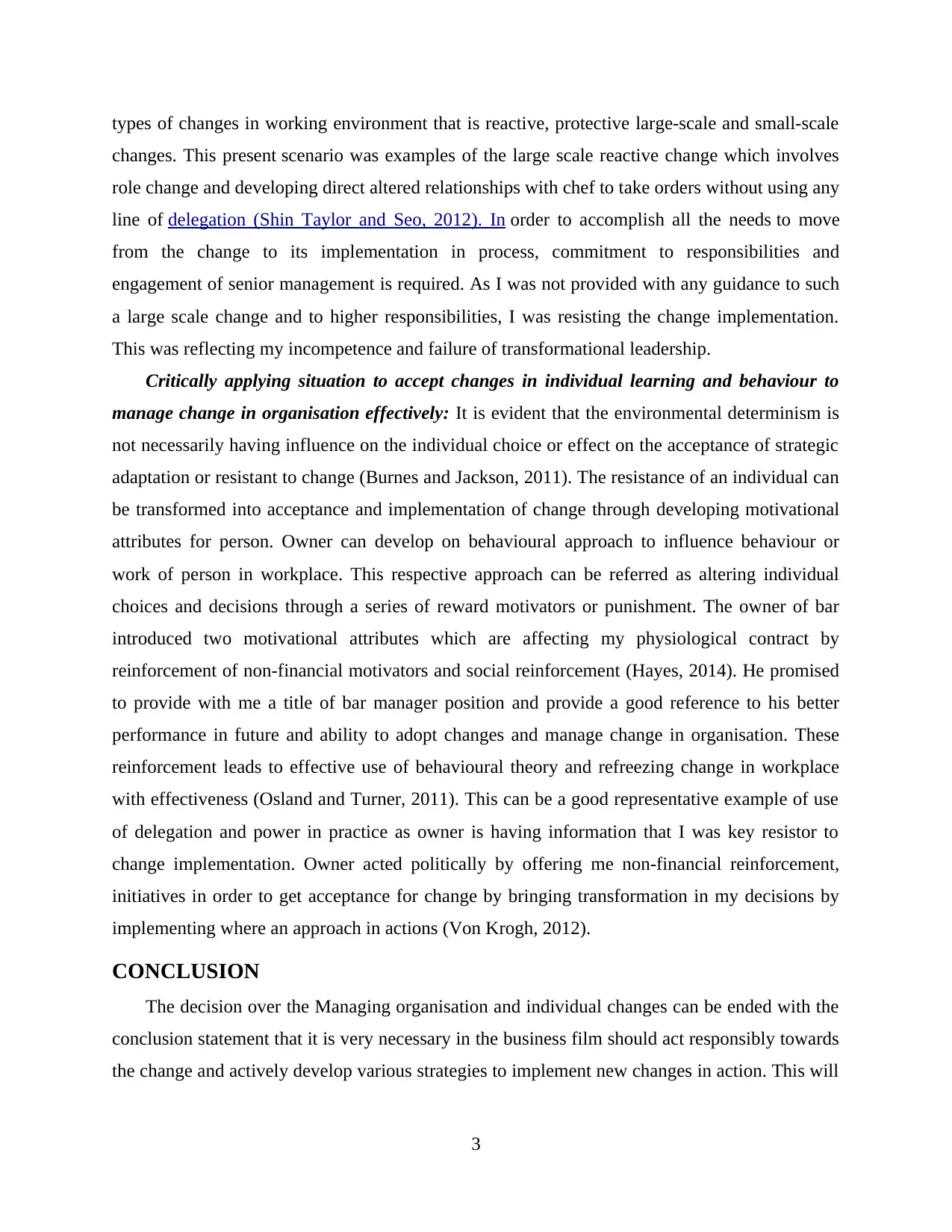
types of changes in working environment that is reactive, protective large-scale and small-scale
changes. This present scenario was examples of the large scale reactive change which involves
role change and developing direct altered relationships with chef to take orders without using any
line of delegation (Shin Taylor and Seo, 2012). In order to accomplish all the needs to move
from the change to its implementation in process, commitment to responsibilities and
engagement of senior management is required. As I was not provided with any guidance to such
a large scale change and to higher responsibilities, I was resisting the change implementation.
This was reflecting my incompetence and failure of transformational leadership.
Critically applying situation to accept changes in individual learning and behaviour to
manage change in organisation effectively: It is evident that the environmental determinism is
not necessarily having influence on the individual choice or effect on the acceptance of strategic
adaptation or resistant to change (Burnes and Jackson, 2011). The resistance of an individual can
be transformed into acceptance and implementation of change through developing motivational
attributes for person. Owner can develop on behavioural approach to influence behaviour or
work of person in workplace. This respective approach can be referred as altering individual
choices and decisions through a series of reward motivators or punishment. The owner of bar
introduced two motivational attributes which are affecting my physiological contract by
reinforcement of non-financial motivators and social reinforcement (Hayes, 2014). He promised
to provide with me a title of bar manager position and provide a good reference to his better
performance in future and ability to adopt changes and manage change in organisation. These
reinforcement leads to effective use of behavioural theory and refreezing change in workplace
with effectiveness (Osland and Turner, 2011). This can be a good representative example of use
of delegation and power in practice as owner is having information that I was key resistor to
change implementation. Owner acted politically by offering me non-financial reinforcement,
initiatives in order to get acceptance for change by bringing transformation in my decisions by
implementing where an approach in actions (Von Krogh, 2012).
CONCLUSION
The decision over the Managing organisation and individual changes can be ended with the
conclusion statement that it is very necessary in the business film should act responsibly towards
the change and actively develop various strategies to implement new changes in action. This will
3
changes. This present scenario was examples of the large scale reactive change which involves
role change and developing direct altered relationships with chef to take orders without using any
line of delegation (Shin Taylor and Seo, 2012). In order to accomplish all the needs to move
from the change to its implementation in process, commitment to responsibilities and
engagement of senior management is required. As I was not provided with any guidance to such
a large scale change and to higher responsibilities, I was resisting the change implementation.
This was reflecting my incompetence and failure of transformational leadership.
Critically applying situation to accept changes in individual learning and behaviour to
manage change in organisation effectively: It is evident that the environmental determinism is
not necessarily having influence on the individual choice or effect on the acceptance of strategic
adaptation or resistant to change (Burnes and Jackson, 2011). The resistance of an individual can
be transformed into acceptance and implementation of change through developing motivational
attributes for person. Owner can develop on behavioural approach to influence behaviour or
work of person in workplace. This respective approach can be referred as altering individual
choices and decisions through a series of reward motivators or punishment. The owner of bar
introduced two motivational attributes which are affecting my physiological contract by
reinforcement of non-financial motivators and social reinforcement (Hayes, 2014). He promised
to provide with me a title of bar manager position and provide a good reference to his better
performance in future and ability to adopt changes and manage change in organisation. These
reinforcement leads to effective use of behavioural theory and refreezing change in workplace
with effectiveness (Osland and Turner, 2011). This can be a good representative example of use
of delegation and power in practice as owner is having information that I was key resistor to
change implementation. Owner acted politically by offering me non-financial reinforcement,
initiatives in order to get acceptance for change by bringing transformation in my decisions by
implementing where an approach in actions (Von Krogh, 2012).
CONCLUSION
The decision over the Managing organisation and individual changes can be ended with the
conclusion statement that it is very necessary in the business film should act responsibly towards
the change and actively develop various strategies to implement new changes in action. This will
3
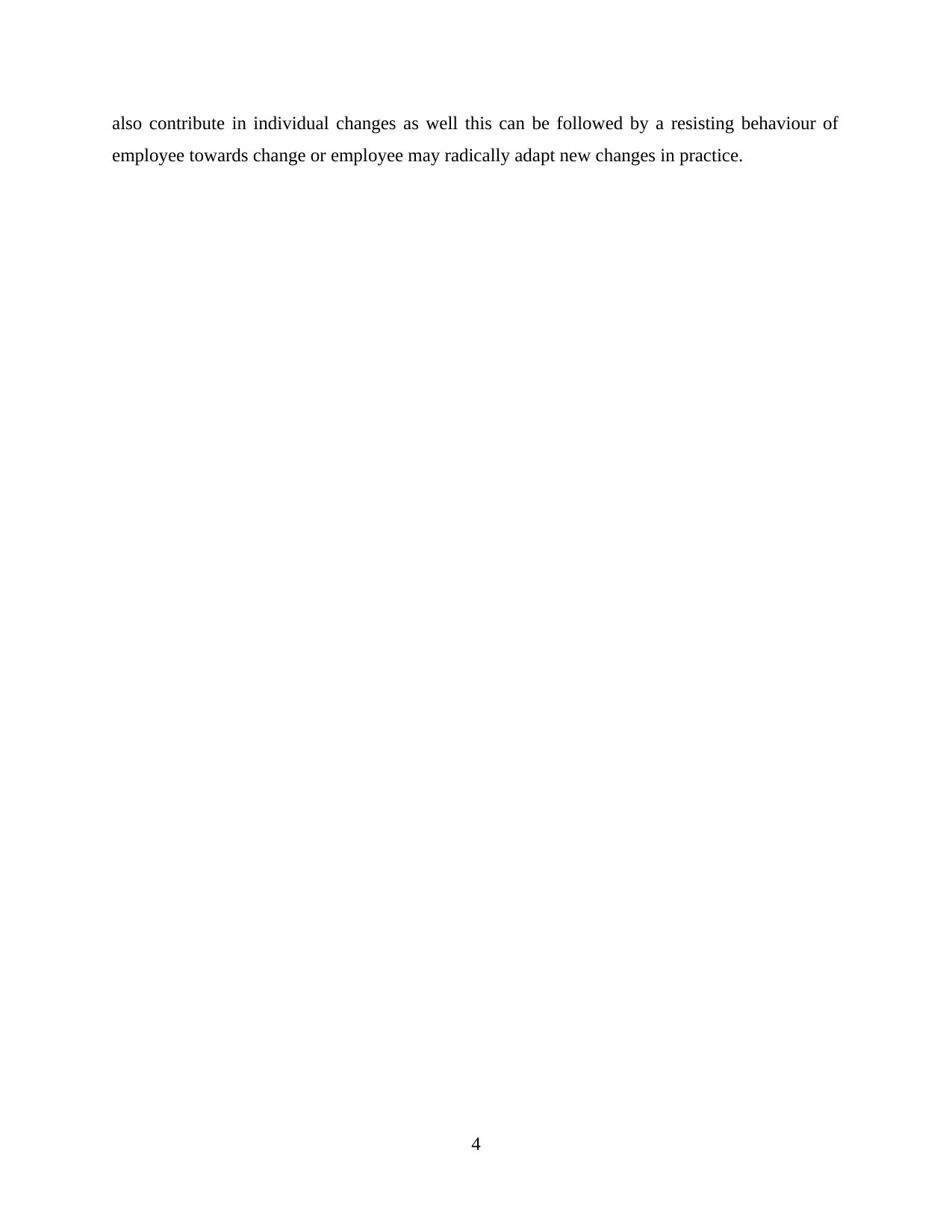
also contribute in individual changes as well this can be followed by a resisting behaviour of
employee towards change or employee may radically adapt new changes in practice.
4
employee towards change or employee may radically adapt new changes in practice.
4
⊘ This is a preview!⊘
Do you want full access?
Subscribe today to unlock all pages.

Trusted by 1+ million students worldwide
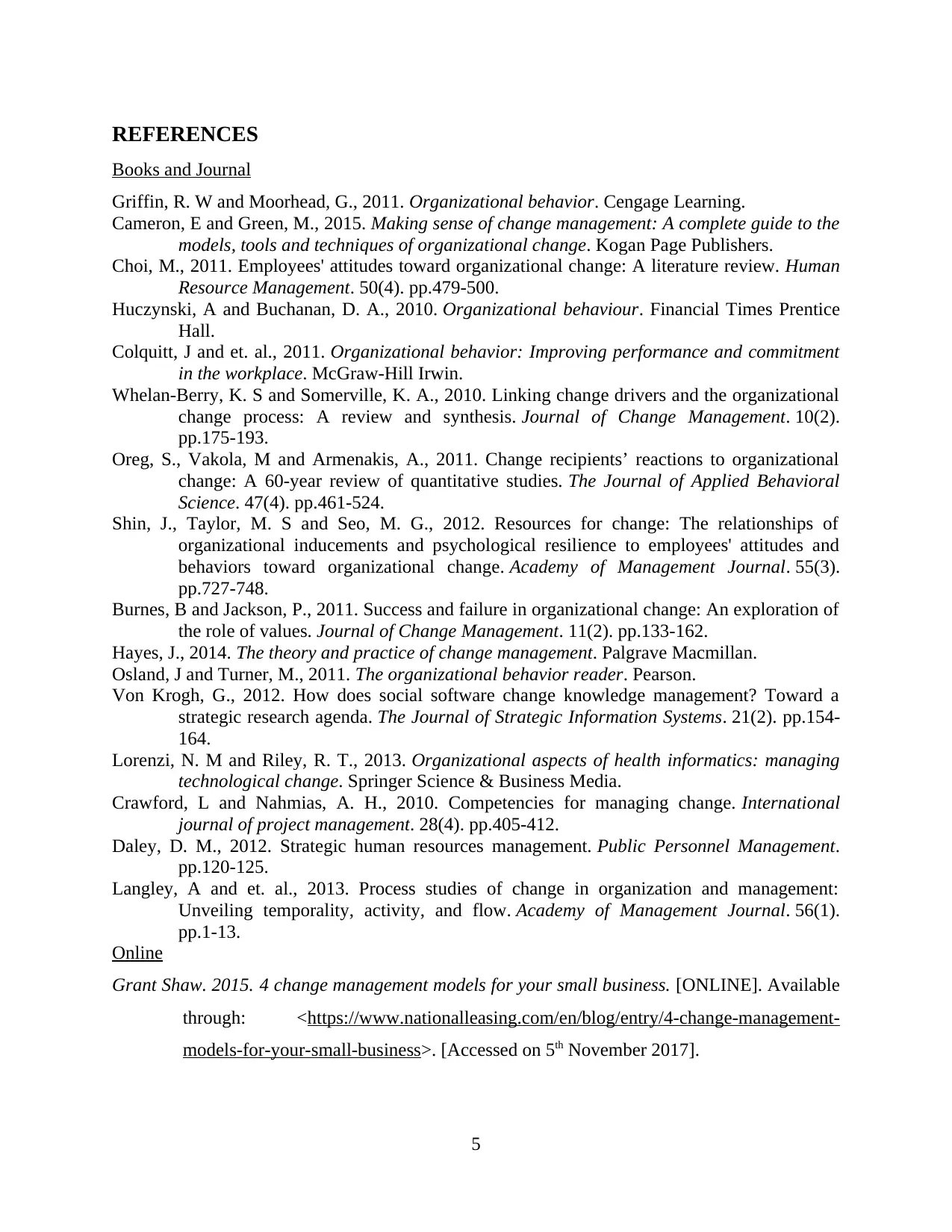
REFERENCES
Books and Journal
Griffin, R. W and Moorhead, G., 2011. Organizational behavior. Cengage Learning.
Cameron, E and Green, M., 2015. Making sense of change management: A complete guide to the
models, tools and techniques of organizational change. Kogan Page Publishers.
Choi, M., 2011. Employees' attitudes toward organizational change: A literature review. Human
Resource Management. 50(4). pp.479-500.
Huczynski, A and Buchanan, D. A., 2010. Organizational behaviour. Financial Times Prentice
Hall.
Colquitt, J and et. al., 2011. Organizational behavior: Improving performance and commitment
in the workplace. McGraw-Hill Irwin.
Whelan-Berry, K. S and Somerville, K. A., 2010. Linking change drivers and the organizational
change process: A review and synthesis. Journal of Change Management. 10(2).
pp.175-193.
Oreg, S., Vakola, M and Armenakis, A., 2011. Change recipients’ reactions to organizational
change: A 60-year review of quantitative studies. The Journal of Applied Behavioral
Science. 47(4). pp.461-524.
Shin, J., Taylor, M. S and Seo, M. G., 2012. Resources for change: The relationships of
organizational inducements and psychological resilience to employees' attitudes and
behaviors toward organizational change. Academy of Management Journal. 55(3).
pp.727-748.
Burnes, B and Jackson, P., 2011. Success and failure in organizational change: An exploration of
the role of values. Journal of Change Management. 11(2). pp.133-162.
Hayes, J., 2014. The theory and practice of change management. Palgrave Macmillan.
Osland, J and Turner, M., 2011. The organizational behavior reader. Pearson.
Von Krogh, G., 2012. How does social software change knowledge management? Toward a
strategic research agenda. The Journal of Strategic Information Systems. 21(2). pp.154-
164.
Lorenzi, N. M and Riley, R. T., 2013. Organizational aspects of health informatics: managing
technological change. Springer Science & Business Media.
Crawford, L and Nahmias, A. H., 2010. Competencies for managing change. International
journal of project management. 28(4). pp.405-412.
Daley, D. M., 2012. Strategic human resources management. Public Personnel Management.
pp.120-125.
Langley, A and et. al., 2013. Process studies of change in organization and management:
Unveiling temporality, activity, and flow. Academy of Management Journal. 56(1).
pp.1-13.
Online
Grant Shaw. 2015. 4 change management models for your small business. [ONLINE]. Available
through: <https://www.nationalleasing.com/en/blog/entry/4-change-management-
models-for-your-small-business>. [Accessed on 5th November 2017].
5
Books and Journal
Griffin, R. W and Moorhead, G., 2011. Organizational behavior. Cengage Learning.
Cameron, E and Green, M., 2015. Making sense of change management: A complete guide to the
models, tools and techniques of organizational change. Kogan Page Publishers.
Choi, M., 2011. Employees' attitudes toward organizational change: A literature review. Human
Resource Management. 50(4). pp.479-500.
Huczynski, A and Buchanan, D. A., 2010. Organizational behaviour. Financial Times Prentice
Hall.
Colquitt, J and et. al., 2011. Organizational behavior: Improving performance and commitment
in the workplace. McGraw-Hill Irwin.
Whelan-Berry, K. S and Somerville, K. A., 2010. Linking change drivers and the organizational
change process: A review and synthesis. Journal of Change Management. 10(2).
pp.175-193.
Oreg, S., Vakola, M and Armenakis, A., 2011. Change recipients’ reactions to organizational
change: A 60-year review of quantitative studies. The Journal of Applied Behavioral
Science. 47(4). pp.461-524.
Shin, J., Taylor, M. S and Seo, M. G., 2012. Resources for change: The relationships of
organizational inducements and psychological resilience to employees' attitudes and
behaviors toward organizational change. Academy of Management Journal. 55(3).
pp.727-748.
Burnes, B and Jackson, P., 2011. Success and failure in organizational change: An exploration of
the role of values. Journal of Change Management. 11(2). pp.133-162.
Hayes, J., 2014. The theory and practice of change management. Palgrave Macmillan.
Osland, J and Turner, M., 2011. The organizational behavior reader. Pearson.
Von Krogh, G., 2012. How does social software change knowledge management? Toward a
strategic research agenda. The Journal of Strategic Information Systems. 21(2). pp.154-
164.
Lorenzi, N. M and Riley, R. T., 2013. Organizational aspects of health informatics: managing
technological change. Springer Science & Business Media.
Crawford, L and Nahmias, A. H., 2010. Competencies for managing change. International
journal of project management. 28(4). pp.405-412.
Daley, D. M., 2012. Strategic human resources management. Public Personnel Management.
pp.120-125.
Langley, A and et. al., 2013. Process studies of change in organization and management:
Unveiling temporality, activity, and flow. Academy of Management Journal. 56(1).
pp.1-13.
Online
Grant Shaw. 2015. 4 change management models for your small business. [ONLINE]. Available
through: <https://www.nationalleasing.com/en/blog/entry/4-change-management-
models-for-your-small-business>. [Accessed on 5th November 2017].
5
1 out of 7
Related Documents
Your All-in-One AI-Powered Toolkit for Academic Success.
+13062052269
info@desklib.com
Available 24*7 on WhatsApp / Email
![[object Object]](/_next/static/media/star-bottom.7253800d.svg)
Unlock your academic potential
Copyright © 2020–2025 A2Z Services. All Rights Reserved. Developed and managed by ZUCOL.




